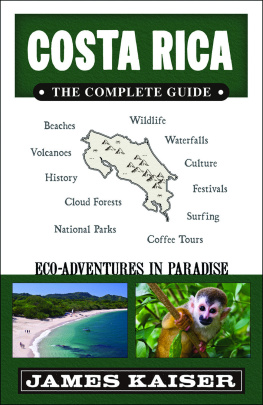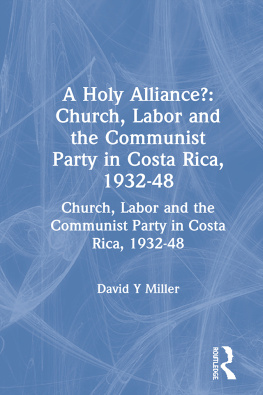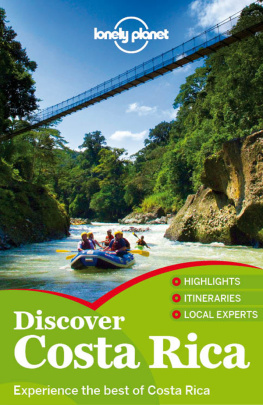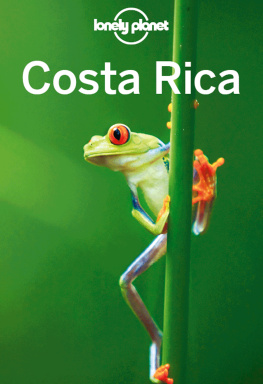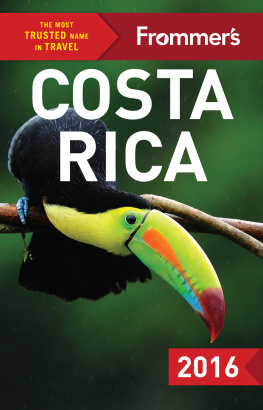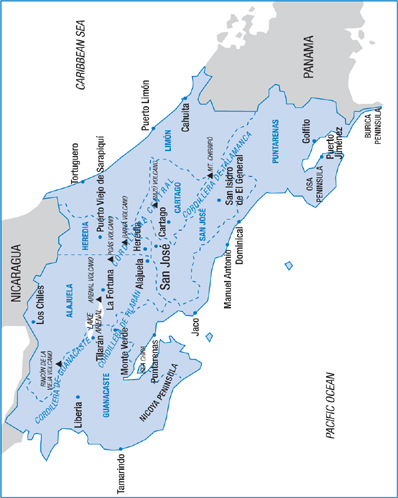eISBN: 978-1-85733-666-5
British Library Cataloguing in Publication Data
A CIP catalogue entry for this book is available from the British Library
First published in Great Britain
by Kuperard, an imprint of Bravo Ltd
59 Hutton Grove, London N12 8DS
Tel: +44 (0) 20 8446 2440 Fax: +44 (0) 20 8446 2441
www.culturesmart.co.uk
Inquiries:
Distributed in the United States and Canada
by Random House Distribution Services
1745 Broadway, New York, NY 10019
Tel: +1 (212) 572-2844 Fax: +1 (212) 572-4961
Inquiries:
Series Editor Geoffrey Chesler
Cover image: Traditional decorated Costa Rican oxcart wheel.
iStockphoto.com
The publishers would like to thank the Costa Rica Tourist Board for permission to reproduce the images on .
Images on the following pages reproduced under Creative Commons Attribution-Share Alike 3.0 Unported license: 14 D.Hatcher/Medeis; 4 HansenBCN; 29 MadriCR; 43 Peter Andersen; 49 and 142 Lex.mercurio; 111 Chepetoo; 130 Eric T Gunther; 136 Haakon S. Krohn
Reproduced under Creative Commons Attribution-Share Alike 2.0 Generic license: 13 Ardyiii; 35 Wendy Lefkowich; 46 Lex.mercurio; 81 Chad Rosenthal; 94 Umacamera; 114 Codo
Copyright 2005, 2012 Kuperard
All rights reserved. No part of this publication may be reprinted or reproduced, stored in a retrieval system, or transmitted in any form or by any means without prior permission in writing from the publishers.
Culture Smart! is a registered trademark of Bravo Ltd.
v3.1
About the Author
JANE KOUTNIK is a teacher, translator, writer, and craft jeweler who has lived in Costa Rica for nearly thirty years. After graduating in Philosophy and English from the University of California at San Diego, she traveled to Costa Rica, fell in love with the country, and decided to call it home. Over the years she has worked for mutual EnglishSpanish understanding in her local rural community, and has contributed to several guidebooks and tourist magazines. Her passion for the environment has led to intensive time and energy dedicated to conservation, working with the government, the local community, and environmental groups.
The Culture Smart! series is continuing to expand. For further information and latest titles visit
www.culturesmart.co.uk
The publishers would like to thank CultureSmart!Consulting for its help in researching and developing the concept for this series.
CultureSmart!Consulting creates tailor-made seminars and consultancy programs to meet a wide range of corporate, public-sector, and individual needs. Whether delivering courses on multicultural team building in the USA, preparing Chinese engineers for a posting in Europe, training call-center staff in India, or raising the awareness of police forces to the needs of diverse ethnic communities, it provides essential, practical, and powerful skills worldwide to an increasingly international workforce.
For details, visit www.culturesmartconsulting.com
CultureSmart!Consulting and CultureSmart! guides have both contributed to and featured regularly in the weekly travel program Fast Track on BBC World TV.
contents
Map of Costa Rica
introduction
Costa Rica is renowned both for its tropical beauty and for the warmth of the Ticosits peoples own name for themselves. The Ticos have a wonderful enthusiasm for life, shown as much in their passion for soccer as in their demonstrations in support of human rights. They are also a proud people, who cherish their democracy in an area that has seen generations of political unrest.
Costa Ricans generally seem more European than their Central American neighbors. Though many ethnic mixtures exist, their Spanish ancestry is the most marked. The population of the Caribbean coast exhibits a blend of Afro-Caribbean, indigenous, and Chinese cultures. There has been a recent increase in immigration from Nicaragua and Colombia, adding another ingredient to the pot, and further immigration of Europeans, North Americans, and Chinese are creating a truly international mix.
There has been burgeoning development in Costa Rica over the last decade. With rapid growth, however, have come growing pains. The middle class is expanding, but there is still a significant and increasing amount of poverty in the country. The national debt has become excessive since Costa Rica leaped feet first into the competitive global economy. Free trade zones, created to encourage foreign investment, have brought in many multinational companies. Over the past few years there has been a profound movement of population to the towns of the Central Valley. Higher education is now the norm for young Ticos, which has put a strain on the national universities, and private universities have opened to meet the need. All these changes have created a challenge for the government in fulfilling the demands of development.
Culture Smart! Costa Rica aims to explore the complex human realities of modern Costa Rican life. Through the descriptions of the countrys history, geography, customs, and traditions, you can see how regional differences and shared values and attitudes have developed. You will get a glimpse of the Ticos home life, of how they do business, and of how they socialize. Armed with this information, you will be better equipped to understand your hosts and to enjoy your visit to the full. This beautiful land offers an intriguing invitation to explore and experience its diverse charms and culture. Costa Rica and the spontaneous hospitality of the Ticos await you with open arms and a smile. Bienvenidos!
Key Facts
| Official Name | Repblica de Costa Rica (Republic of Costa Rica) |
| Capital City | San Jos | Pop. 300,000 approx |
| Population | 4,576,572 (2012) |
| Area | 19,730 square miles (51,100 square km.) |
| Geography | Situated in the heart of the Central American isthmus, which connects North and South America | Bordered to the north by Nicaragua, to the southeast by Panama, to the west by the Pacific Ocean, and to the east by the Atlantic Ocean |
| Terrain | A backbone of volcanoes and mountains through the center divides the Pacific and Atlantic slopes. Two coastlines of tropical beaches, lowland rain forests, high-altitude cloud forests, humid, verdant northern plains, and the dry savannahs of Guanacaste create a broad diversity. |
| Climate | Tropical. There are two seasons, the wet season, invierno (winter), May-Nov., and the dry season, verano (summer), Dec.-April. | Altitude greatly affects climatic conditions and temperatures. |
| Currency | The colon, which devalues annually about 10 percent. | In 2012, US $.00 equalled 505 colones. |


